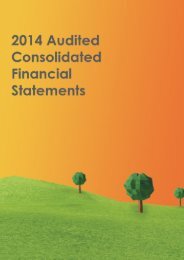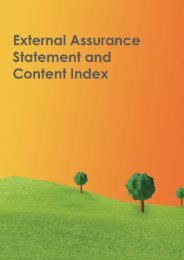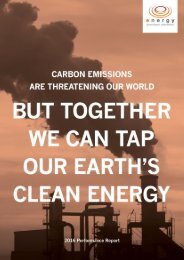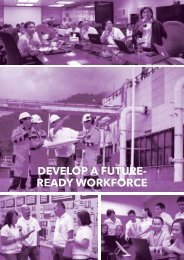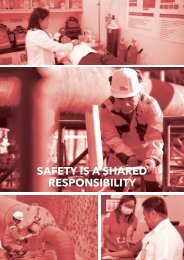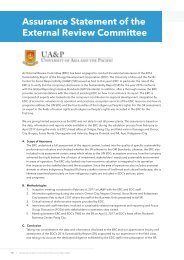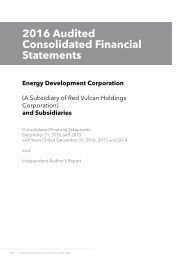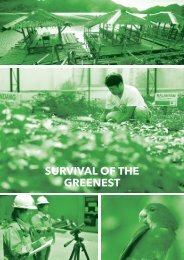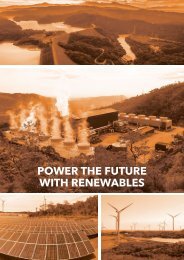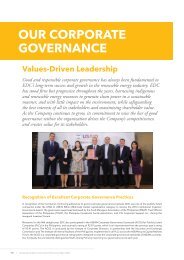EDC 2014 SR (UPDATED)
Create successful ePaper yourself
Turn your PDF publications into a flip-book with our unique Google optimized e-Paper software.
<strong>EDC</strong> <strong>2014</strong> Performance Report<br />
One investor went so far as to say:<br />
“<strong>EDC</strong> Management has done really<br />
well this year. They are able to<br />
communicate their plans and strategy<br />
and address the issues and concerns<br />
that have come their way in the past<br />
year. I would like to reinforce that they<br />
are doing really well and I hope it<br />
continues.”<br />
With the confidence of the investors<br />
gradually returning, our stock has<br />
performed really well in <strong>2014</strong>, ending<br />
the year at ₱8.2 per share, up by<br />
54%, which is understandable given<br />
the 40% increase in RNI attributable<br />
to <strong>EDC</strong>. This year though, we have<br />
given some guidance that because<br />
of the contract re-pricing and the<br />
transmission constraints that are<br />
being experienced by the Burgos<br />
Wind project, the growth will not be<br />
40%, as previously expected by the<br />
market.<br />
In addition to the improving<br />
perception of our equity investors,<br />
we are blessed by the confidence of<br />
the debt capital markets. In a recent<br />
re-financing effort for our subsidiary<br />
GCGI, we received firm offers of ₱29.3<br />
billion as we went to market with a<br />
requirement of ₱8.5 billion. The 3.5x<br />
of commitments allowed us to lower<br />
the interest rate on the company by<br />
close to 3% and will save us close<br />
to ₱250 million a year in interest<br />
expense. As we continue to pursue<br />
growth locally and overseas, we will<br />
need additional financing. We need<br />
to nurture the continued interest and<br />
support of the capital markets for our<br />
company.<br />
5<br />
BUILDING A WORLD-CLASS ORGANIZATION<br />
The fifth building block of our business<br />
is our cadre of highly engaged<br />
employees.<br />
There are many, many changes that<br />
have made the <strong>EDC</strong> of today a place<br />
only for the most flexible and resilient<br />
employees. To give you color and<br />
context, the past seven years have<br />
been a period of tumultuous change<br />
for <strong>EDC</strong>’s employees. Through a<br />
combination of early retirement<br />
programs and management-initiated<br />
restructuring programs, the total<br />
PNOC-<strong>EDC</strong> headcount, including<br />
contractuals, dropped from over<br />
3,000 people to around 1,400.<br />
As this was happening, we embarked<br />
on a series of strategic acquisitions<br />
starting from the 60% of FG Hydro, the<br />
Tongonan Power Plant, the Palinpinon<br />
Power Plants, and the Bacman Power<br />
Plants for a combined capacity of<br />
547MW. Since then, we have added<br />
30MW through upgrades of Bacman<br />
units and the relocation of the power<br />
plant in Northern Negros to Nasulo.<br />
We also made two international<br />
acquisitions: 100% Hot Rock, Ltd. and<br />
70% of Alterra Power Corporation’s<br />
concessions and applications in Chile<br />
and Peru. These acquisitions brought<br />
up our headcount to today’s 2,400—<br />
still below the original complement—<br />
while our business has nearly doubled<br />
its income.<br />
Not surprisingly, when we first<br />
measured employee engagement<br />
in 2010, our overall score using<br />
the Positive Engagement Index of<br />
Surveys@Work was a poor 59%. This<br />
was well below the Philippine norm<br />
and global best benchmarks. This<br />
provided us the impetus for change<br />
in the way we manage promotions,<br />
salary increases, apportion and<br />
provide our training opportunities,<br />
gather as leaders to set strategy, and<br />
communicate. We made adjustments<br />
and got rid of decades-old processes<br />
from the old government way of<br />
running things.<br />
Employee engagement score<br />
59%<br />
70%<br />
88%*<br />
2010 2012 <strong>2014</strong><br />
(*3% higher than the Philippine national norm, 9% higher than 41 energy and utility companies<br />
that make up global best benchmarks and 4% higher than the 27 highest performing companies<br />
that make up global best benchmarks)<br />
By 2012, our employee engagement<br />
score climbed to 70%. While still<br />
mediocre, we knew we were on<br />
the right path. So we made further<br />
adjustments in how we work with our<br />
labor unions, which we do now with<br />
transparency. I now hold an annual<br />
meeting with the union presidents and<br />
I share with them our priorities and<br />
goals for the year. We also significantly<br />
enhanced the flow of information and<br />
continued to hold more site-based<br />
Mancom meetings where senior<br />
management would do a half-day of<br />
highly visible safety walks. We keep<br />
This page contains the following GRI indicator(s):<br />
G4-1, G4-PR5<br />
23




